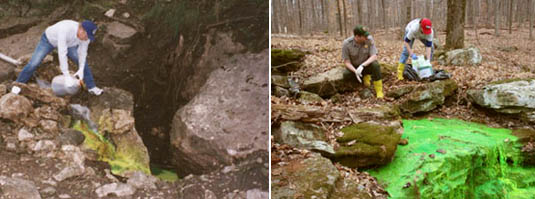 [Image: From Google Maps].
[Image: From Google Maps].
Many weeks ago, after listening to the podcast S-Town, I got to looking around on Google Maps for the now-legendary hedge maze designed by the podcast’s protagonist, John B. McLemore. Other people, of course, had already found it.
As these things always go, however, I began panning around the map of the region, following waterways and forests to various places, zooming in on interesting geological features and more, and eventually found myself looking at a strange patch of forest on the Arkansas/Missouri border. In a place called the Big Lake Wildlife Management Area, huge glyphs have been cut into the trees, in repetitive shapes that appear to be letters or runes.
There are distended Ss, upside-down Us that resemble hoofprints, cross-like forms that could be lower-case ts or + signs, and simply large, empty blocks. The figures repeat across the forest in no apparent pattern, but they are clearly artificial. I figured these were a property-marking system of some sort, or perhaps some kind of recreational landscape, leading to a series of unusually elaborate hunting blinds; but they could also have been—who knows—an optical calibration system for satellites, cut deep in the woods, or perhaps, if we let our imaginations roam, some secret government design agency performing unregulated typographic experiments in the forest… Perhaps it was really just SETI.
Then I stopped thinking about them.
 [Image: From Google Maps].
[Image: From Google Maps].
When I mentioned these to my friend Wayne the other night, however, he was quick to dig up the real explanation: “the odd shapes are part of a habitat restoration project,” local news channel KAIT reported back in 2013.
“In wildlife management, you know, disturbance is a good thing,” biologist Lou Hausman explained to KAIT. “When you put sunlight to the forest floor, that’s one of the basic components of habitat management. It stimulates growth in the understorage and stimulates growth on the ground.”
The different shapes or letters were thus chosen for research purposes, the goal being to learn which ones produced the best “edge effects” for plants and wildlife on the ground. If the S shape allowed more efficient access to sunlight, in other words, well, then S shapes would be used in the future to help stimulate forest recovery due to their particular pattern of sunlight.
Think of it as ecosystem recovery through typography—or, heliocentric graphic design as a means for returning forests to health. Kerning as a wildlife management concern.
This perhaps suggests a unique variation on artist Katie Holten’s “Tree Alphabet” project, but one in which alphabetic incisions into a forest canopy are done not for their literary power but for their strategic ecosystem effects. Golem-like sections of wilderness, brought back to health through language.
(Thanks to Wayne Chambliss for his champion-league Googling skills).
 [Image: Photo by Charles Ray, via the New York Times].
[Image: Photo by Charles Ray, via the New York Times]. [Image: From
[Image: From  [Image: From
[Image: From 
 [Images: Dye-tracing cave systems; note that the chemical used is supposedly non-toxic].
[Images: Dye-tracing cave systems; note that the chemical used is supposedly non-toxic]. [Images: Dye-tracing caves].
[Images: Dye-tracing caves].